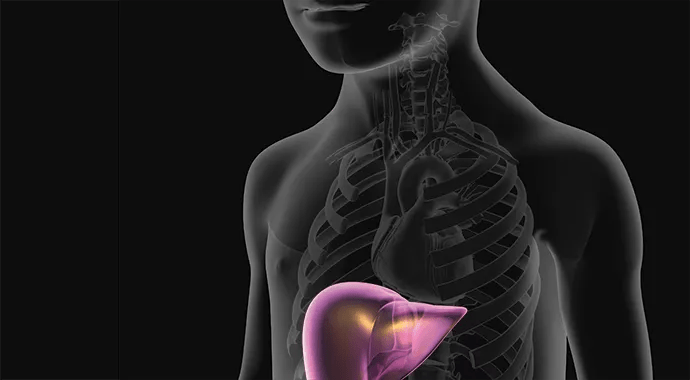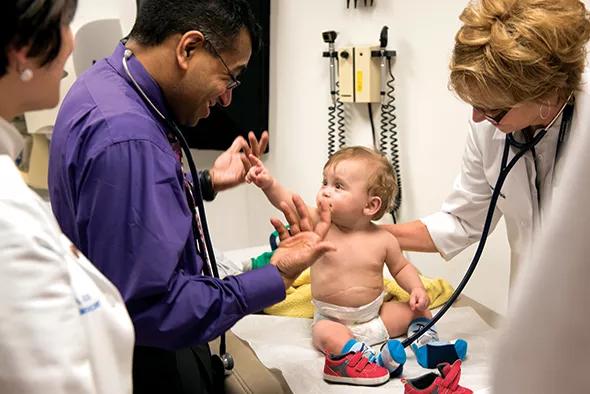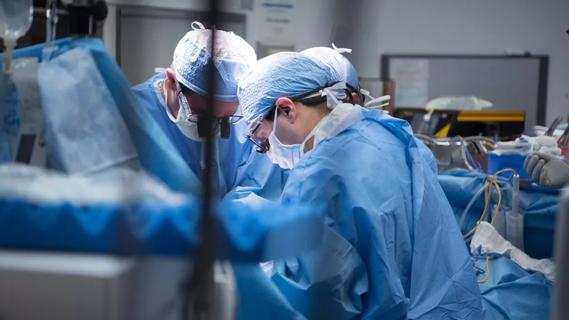Particular benefits for this infant with biliary atresia

2015 marks the 30th anniversary of the first liver transplant performed in a child at Cleveland Clinic. Three decades and more than 100 pediatric liver transplants later, no development in liver transplantation at Cleveland Clinic Children’s has been more significant than the advent of living-donor transplants.
Cleveland Clinic is a non-profit academic medical center. Advertising on our site helps support our mission. We do not endorse non-Cleveland Clinic products or services. Policy
When combined with split-liver transplants from deceased donors, transplants of partial liver grafts from living donors represent approximately half of all pediatric liver transplant cases at Cleveland Clinic Children’s over the past 10 years. Together these options, which are offered aggressively at Cleveland Clinic Children’s, are increasing transplant opportunities for pediatric patients with serious liver disease at a time of pressing organ shortages.
In addition to supplying smaller liver grafts well-matched to children’s small bodies, living-donor liver transplantation can give young patients and their families the option of planning the timing of their transplant in advance. And it can slash wait times for ill infants and children in desperate need of a new liver, often with profound implications for their survival and development.
Little Angelo (pseudonym to protect his privacy) is a case in point. Born at Cleveland Clinic Children’s in February 2014, Angelo’s bilirubin levels escalated over his first few weeks of life. When his gallbladder could not be visualized on imaging, he was referred to Kadakkal Radhakrishnan, MD, of Cleveland Clinic Children’s Department of Pediatric Gastroenterology, for a series of exams.
“Dr. Radhakrishnan suspected Angelo had biliary atresia, but its diagnosis is not straightforward,” says Angelo’s mother. “So he guided us through a stepwise process to confirm his suspicion or identify an alternate diagnosis.”
That process included starting a medication to thin the child’s bile and a special formula-based diet, but the success of these measures was short-lived. A rebound in bilirubin prompted an interventional cholangiogram by pediatric general surgeon David Magnuson, MD.
When the procedure revealed atretic biliary structures, biliary atresia was confirmed and Dr. Magnuson immediately performed a Kasai procedure to directly connect the porta hepatis to the small intestine to allow bile drainage. Angelo was just 6 weeks old at this point.
Modest reductions in his bilirubin followed, but three months later the levels began to rise again. By the time Angelo turned 6 months old, his condition had deteriorated significantly. “He was really sick, really weak,” his mother says. And he had essentially stopped growing. “His height and weight stayed the same for three months,” she adds.
“That was the signal that a liver transplant was needed,” says Dr. Radhakrishnan. “When these patients stop growing, it’s time to act fast, before they deteriorate so much that the prospects of the surgery might be impaired as well.”
So Angelo was listed for a liver transplant in early autumn 2014. But because his pediatric end-stage liver disease (PELD) score was not dramatically elevated, it may have been months before he received a donor organ. “That would have been detrimental to his development and his overall health,” his mother recounts.
So Angelo’s parents each underwent evaluation to be a potential donor for their son under the counsel of Charles Miller, MD, Surgical Director of Cleveland Clinic’s Liver Transplantation Program. “We felt a related living-donor transplant was the best solution,” Angelo’s mother says, “because it would let us plan the timing of Angelo’s transplant and make it possible far sooner than his PELD score would have dictated.”
Because Angelo was so small for his age as a result of his compromised health, his father’s liver was deemed too large for him. His mother was determined to be an appropriate donor, and in mid-November 2014 she donated the lateral segment of her liver — about 20 percent of the organ’s total size — to her son. The surgeries on both mother and child went smoothly, with the mother being discharged after one week and Angelo after two weeks.
Both have recovered without problems, and Angelo has been free of rejection episodes. He was strong enough to successfully weather a bout of rotavirus in February 2015, and his liver function values are optimal. And after the months of stagnant growth prior to the transplant, “he is growing impressively,” his mother notes. “Angelo is his usual happy self again. It’s like he’s been reborn. Kids can be amazingly resilient.”

Faring well four months postop. Angelo with his pediatric gastroenterologist, Kaddakal Radhakrishnan, MD (in purple), and team members at a checkup visit in March 2015.
Equally resilient is his mother’s liver, which regenerated fully within five weeks of her operation. Her liver function values were back to normal by her second postoperative checkup, and she was back to work and her usual activities within six weeks of her surgery.
As Angelo’s parents revel in the resumption of his growth, they credit his being back on track developmentally to having the option to offer him a living-donor transplant — a capability not all pediatric transplant centers offer. The fact that Angelo’s liver graft came from a related donor — one whose body was his home just a few months earlier — may allow him to fare well with a relatively low-dose immunosuppressant regimen, although only time can tell.

Careful risk stratification is key

Findings support the safety of the technique

Insights from murine models could help guide care for patients

Reviewing how the drug can be incorporated into care

Insights on guiding treatment decisions

Largest, longest analysis to date shows greater weight loss and fewer diabetes medications needed

Strong patient communication can help clinicians choose the best treatment option

ctDNA should be incorporated into care to help stratify risk pre-operatively and for post-operative surveillance